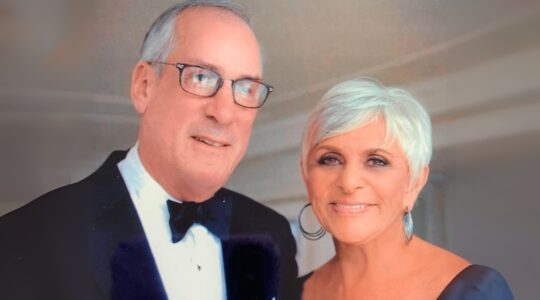BALTIMORE (JTA) – Gil Marks baked. He cooked. He authoritatively discussed culinary traditions – traditions, period – of Jews from seemingly every culture. Trained as a rabbi and social worker, he earned prestigious awards for writing cookbooks yet remained supremely humble. He had a slightly high-pitched voice.
I knew none of this five years ago when I came upon his name, overwhelmed like a pinch of salt in a bowlful of ingredients, amid the prodigious clan produced by Harold and Beverly Marks. “Gilbert Stanley Marks, born in 1952 in Charleston, W.Va., unmarried, no children” was his one-line entry on a 19-page family tree prepared by our cousin in Washington state.
His brother, a Baltimorean, referred me to Gil, a resident of Manhattan’s Upper West Side, when I sought information for research on our extended family. That led to our long conversation that night, two meetings when Gil visited Baltimore, occasional phone calls, periodic emails and multiple Facebook messages.
Many people consider fourth cousins – our common great-great-great-grandfather, Zeev Alkovitzky, of Lithuania was born in about the 1830s – distant relatives. But Gil and I connected immediately.
We reveled in genealogy and Jewish history. We emailed our articles to each other. We both enjoyed cooking, I deign to state in the manner of someone painting by numbers proclaiming that he, like Monet, is an artist. Gil won the James Beard Foundation Award, for goodness sake, for authoring “Olive Trees and Honey: A Treasury of Vegetarian Recipes from Jewish Communities Around the World,” and contended for a second with “The Encyclopedia of Jewish Food,” a masterpiece.
“There were so many books in him and a lot more he could’ve contributed to the world,” said Rita Rosenkranz, his agent of more than a decade.
Gil’s death last Friday at 62 hardly shocked those who knew him, given his three-year fight with lung cancer and his public sharing of the ordeal. While not a smoker, he didn’t bemoan his affliction, just presented it matter-of-factly. Numerous Facebook posts on his medical treatment or pharmaceutical regimen all began thus: “The Saga Continues.”
Far more posts kvelled over his beloved nieces and nephews regularly visiting Alon Shvut, where Gil lived in an apartment at his parents’ home during extended stays in Israel. So many more posts covered food: the Shabbat dinner menu he’d just prepared, Passover desserts he baked, magazine articles, cooking lessons given as bat mitzvah presents.
Last summer, as Gil’s condition worsened, some posts overlapped. On Sept. 1, he began taking medical marijuana: dissolved in olive oil in the afternoon, in a capsule at bedtime.
“For weeks before starting the marijuana, I was unable to eat or function. Overnight – with a single drop – my condition changed and subsequently I have been able to eat and actually enjoy food. … The improvements in my life since I was introduced to marijuana cannot be overstated,” he wrote.
An ailing foodie appreciating taste once more, dayenu – that would’ve sufficed. But Gil couldn’t resist shifting to culinary-educator mode.
“By the way, for those of you who asked about marijuana brownies, here is the story” – he began in a fascinating paragraph covering Alice Toklas and a Peter Sellers film involving pot brownies.
About the only thing missing was the baking temperature.
Gil enthralled, too, during a weekend’s scholar-in-residence stint at my synagogue in June 2012, highlighted by a Saturday-night tasting that paired chocolates and wines.
Los Angeles-based food writer Tori Avey, whose website includes recipes inspired by the past, enticed Gil to contribute monthly columns. He wrote on American cakes and their background – the subject of his last book, which Rosenkranz is shopping to publishers.
“I thought it was a fantastic idea, and my readers agreed,” Avey said of Gil’s cake columns, the last two of which (on Black Forest Cherry Cake and on Molten Chocolate Cake) will run in January. “They brought up a lot of nostalgic feelings for people who have grown up cooking and eating these treats.”
Somehow, Gil performed his culinary magic on a tiny stove in a small kitchen “where you couldn’t sit down,” said Barry List, a longtime friend, who saw pots stored in the living room and platters cooling on the couch in Gil’s Manhattan apartment.
In a telephone conversation last spring, Gil told me he’d begun giving away choice cookware to New York-area nieces and nephews. He understood that experimental drugs were a long shot and said, convincingly, “I’m not afraid of dying.” He seemed gratified that loved ones desired the tools of his trade.
Last week, a friend visited Gil at a Jerusalem hospice and had him autograph her “Olive” and “Encyclopedia” books. She posted a photo showing Gil signing while in bed wearing a hospital gown and a skull-encompassing kipah. The autograph request pleased him, she wrote.
As I penned this article, a pot of soup bubbled on my stove. There was no recipe – just flanken bones, chopped carrots, green beans, onions and potatoes; and lentils, barley, peas and beans, a winter’s staple my mom used to make.
I lowered the flame, and as it simmered I discovered some old emails from Gil. One carried the subject line “Hillel’s soup question” – about this very soup. I’d asked what spices would provide richer flavor.
Gil offered a paragraph each of suggestions for Italian mixed-herb, Yemenite, basic and sweet-spiced flavors.
“I hope,” he wrote, “this has been of help.”
The soup, Gil, is comfort food.
JTA has documented Jewish history in real-time for over a century. Keep our journalism strong by joining us in supporting independent, award-winning reporting.







